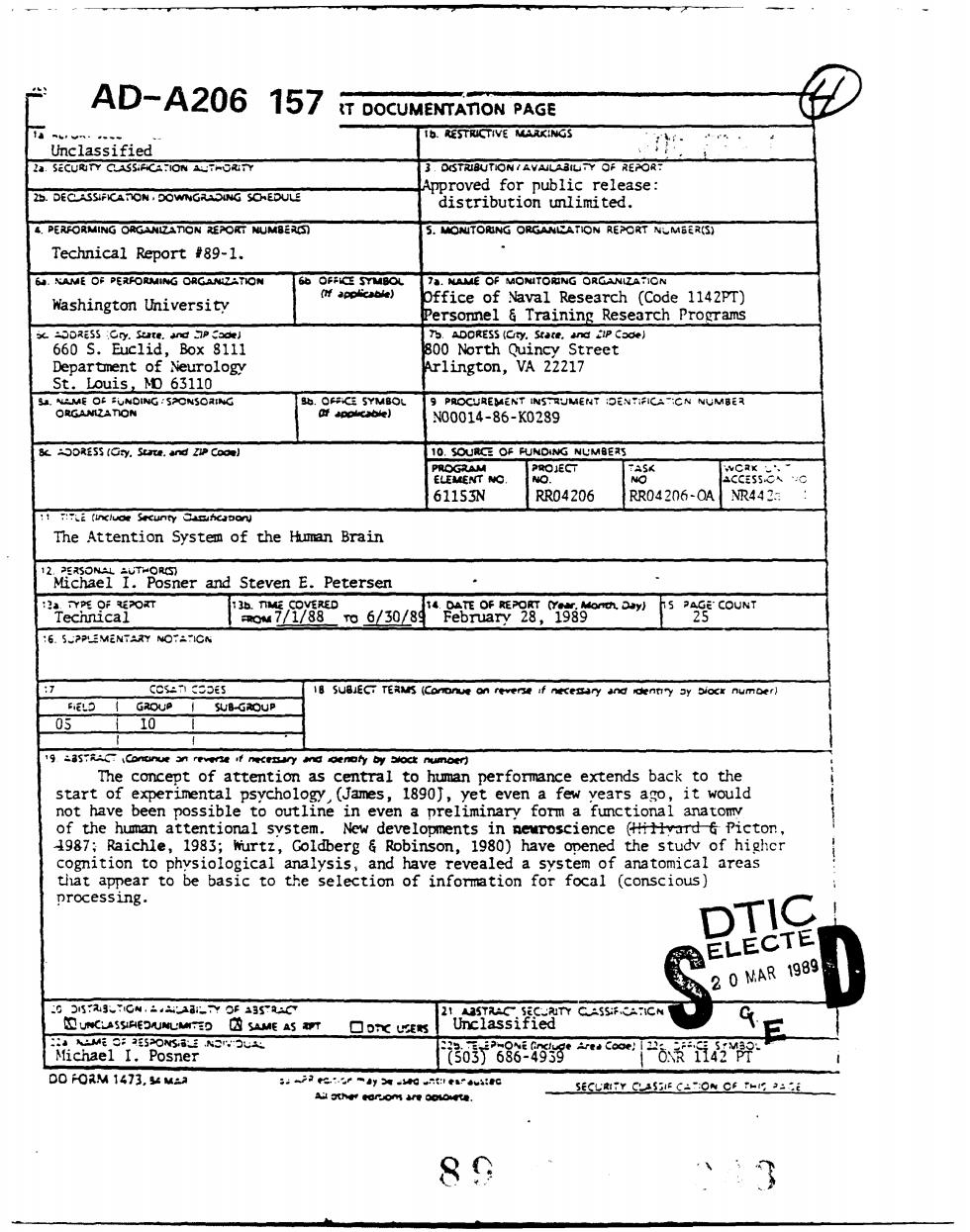
AD-A206 157 T DOCUMENTATION PAGE Unclassified 4 PERFORMING O☑ Technical Report #89-1. maT Washington University ersonnel 6 Training Research Programs 设,0 Ss 01486K0239 JMENT元NCA-CN NUMBE习 RESS (Gry.Sute.and Coo) 10.SOURCE OF PUNDING NLMBERS 5s 61153N RR04206RR04206-0AXR442 The Attention System of the Hman Brain and Steven E.Petersen Technicalo 05 10 19R Cononuee ny and ofnaly by Sock New icalanalysis.and have revealed DTIC ELECTE 20MAR1989 Uneiassc CC 活0j6336浴”o6煮置2学 DO FORM 1473.M 89
AD-A206 157 ,T DOCUMENTATION PAGE l. ESMTaCTIVE MAA NiGMS Unclassified O , ,"O" 2a SECURirY C-.SS.-..N 3. 0tSTRJ8UTIONIAVAiLf4IU ' Y OF REPORT Approved for public release: Z. DECLASS ICA-,ON 0ow,,Ja-NNG SO'UL-E distribution unlimited. 4. PERFOMING~ ORG-ANZATION RE.POR N4UM8FSM S. 'ACWTO6ING ORCJ6NLATION REPORT N4,MSER(S) Technical Report #89-1. 6,a. %rAME O; PERORMNG ORGAZ.ATION 6b OP;;IC SO . 7a. kAA OF MOW4TOmNG ORGANIZA-ION Washington University 'f , ffice of Naval Research (Code 1142PT) ersonnel & Training Research Prozrams .- .Z-0RESS [Cr. Sure. WWI -"7P odeJ b ADORESS (City. Sate. am :IP Cooe) 660 S. Euclid, Box 8111 00 North Quincy Street Department of Neurology lington, VA 22217 St. Louis IMD 63110 Ui. 14.Me 0; UNOLNG:SPOiS0;aIkG &b. 0"<:- SYMBOL 9PROCI EbAENT INS71MENT ON C;<A-CN NUMBER ORGANoZATION " N00014-86-K0289 5L ;O-ASS (0 y. Staw. and ZP Co=o) 10. SOURCI OF PIJNCNG NUMSERS PROKPAM PROJECT, rASK V- - ELEME1T NO. N O. .CFSS.c',, E '-'C '61153N RR04206 'RR04206-OA NR4422- 7!7L (rKIrLc' SeCURVY ?-fCa tPIco Vj The Attention System of the Human Brain 12. PERSONAL ALTi..ORM5 Michael I. Posner and Steven E. Petersen '2a. -,Y*.K OF REPORT 13b. flME COVERED 4. DATE OF REPORT (Y~. AionU',k. Day) 5 PA-GE'COUNT Technical mom 7/1/88 To 6§/30/8 February 28, 1989 25 "6. 5.PPLEM.NT.RY NO-"'I7GN :7 CCS,;.TI Z-.:ES I 1 6 SU8JECT TERMS (Caru om an 'e-,,se J ,eCeunay and ,lr,'-y my biocx numoer) riEL' GROUP ISUB-GROUP 05 1 10 I 11 Z-as-RAC7 kcanaermj ~ran .f PWV.~avy and 4IOty by -W=~ nufflaer The concept of attention as central to human performance extends back to the start of experimental psychology (James, 1890j, yet even a few years ago, it would not have been possible to outline in even a preliminary form a functional anatomy of the human attentional system. New developments in newrmscience (+H-lfnrd & Picton, 4987; Raichle, 1983; Wurtz, Goldberg & Robinson, 1980) have opened the study of highcr cognition to physiological analysis, and have revealed a system of anatomical areas that appear to be basic to the selection of information for focal (conscious) processing. ~ '5ig T -.. aa..y iai ~ ES~.'21 AISTUcC SiC.-Airv-,S;rC;-C MuwCL~ss-ieoDumuur-o sAme As wT 0 O7'C Unclassified :2a ,,. ;..Z F. C ,'': a=..SO . .. 2t= 'r .. ; :P O'tt. r, ,.t C:.e. C , + Michael 1. Posner I/ : r.,_ , o ,I 50m 686 -49A c oo . 1142 PT DO OQ W 1473, m-_a .- . . , : ..-. , e.: '.: sEcLMY C .;I, c"-:Oo c OFg , . - 89 x a
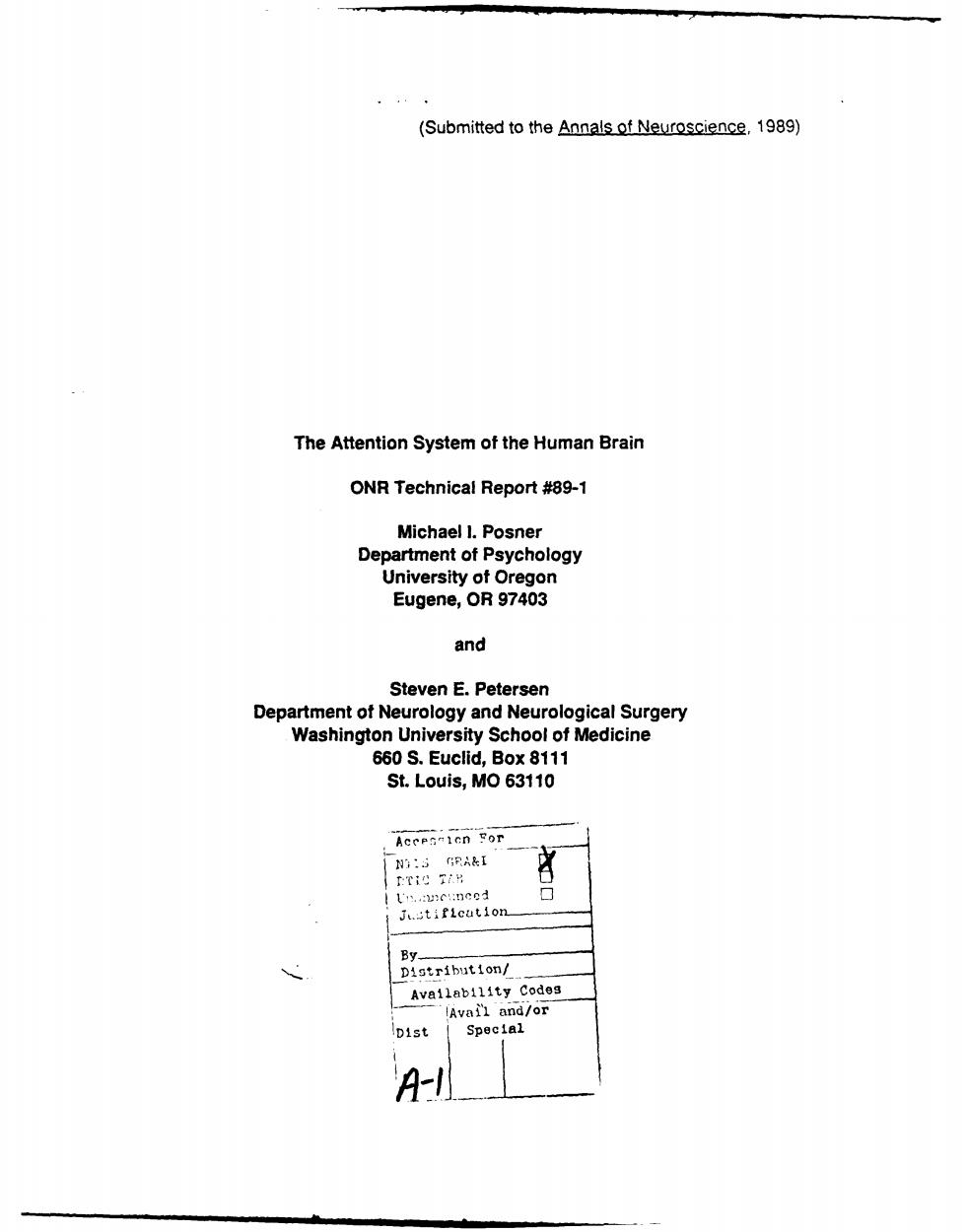
(Submitted to the Annals of Neuroscience,1989) The Attention System of the Human Brain ONR Technical Report #89-1 Michael l.Posner Department of Psychology 2oat0A97a38” and Steven E.Petersen Department of Neurology and Neurological Surgery Washington University School of Medicine 660S.Euclid,Box111 St.Louis,MO 63110 Acers-icn Por Distribution/ Availability Codes A
(Submitted to the Annals of Neuroscience, 1989) The Attention System of the Human Brain ONR Technical Report #89-1 Michael I. Posner Department of Psychology University of Oregon Eugene, OR 97403 and Steven E. Petersen Department of Neurology and Neurological Surgery Washington University School of Medicine 660 S. Euclid, Box 8111 St. Louis, MO 63110 B - n -n-o Availability Codes ; -Avai'l and/or IDist Special
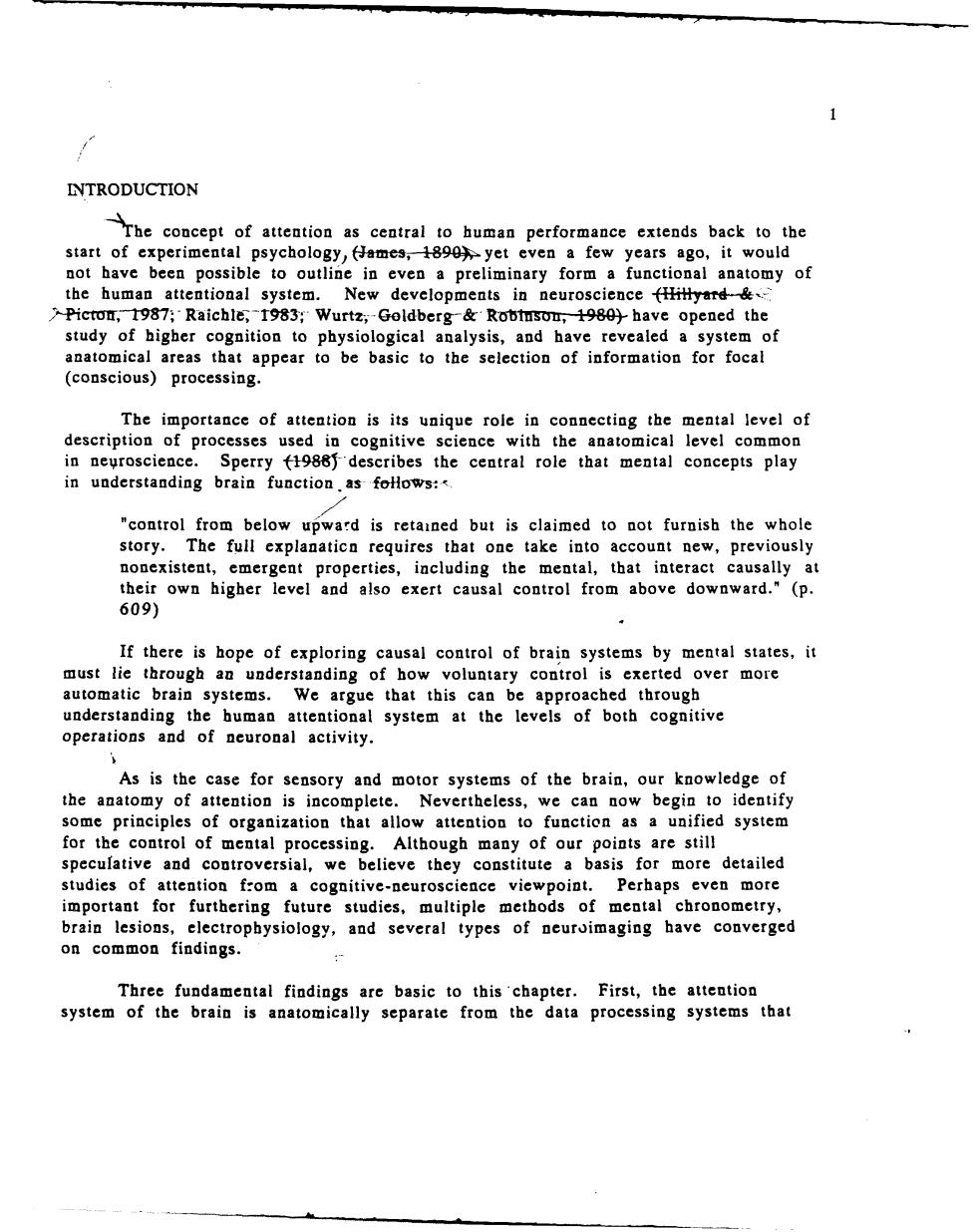
INTRODUCTION The concept of attention as central to human performance extends back to the start of experimental psychology,(ames,1890)yet even a few years ago,it would not have been possible to outline in even a preliminary form a functional anatomy of the human attentional system.New developments in neuroscience fHiHyard& Picton,1987:Raichle;-1983:Wurtz:-Goldberg&Robtnsom 1980)have opened the study of higher cognition to physiological analysis,and have revealed a system of anatomical areas that appear to be basic to the selection of information for focal (conscious)processing The importance of attention is its unique role in connecting the mental level of description of processes used in cognitive with the anate mical level common in neuroscience. Sperry (1988)de cribes the central role that mental concepts play in understanding brain function as fo "control from below story. Th full exp es,including the theisown higher level exert caua conto from above dowaward. ergen men (P 609) If there is hope of exploring causal control of brain systems by mental states,it must lie automatic ayeanirggglralege9peg6g6eraore th understanding the human attentional system at the levels of both cognitive operations and of neuronal activity. As is the case for sensory and motor systems of the brain,our knowledge of the anatomy of attention is incomplete.Nevertheless,we can now begin to identify some principles of organization that allow attention to function as a unified system for the control of mental processing.Although many of our points are still speculative and controversial,we believe they constitute a basis for more detailed studies of attention from a cognitive-neuroscience viewpoint.Perhaps even more important for furthering future studies,multiple methods of mental chronometry, brain lesions,electrophysiology,and several types of neurvimaging have converged on common findings. Three fundamental findings are basic to this'chapter.First,the attention system of the brain is anatomically separate from the data processing systems that
/ INTRODUCTION - lrhe concept of attention as central to human performance extends back to the start of experimental psychology, (,&mes,-44W,90 yet even a few years ago, it would not have been possible to outline in even a preliminary form a functional anatomy of the human attentional system. New developments in neuroscience '-'. 2 -Picroa,--1-9S7,- Raichk,-t983; Wurtz-Goldberg-& R - have opened the study of higher cognition to physiological analysis, and have revealed a system of anatomical areas that appear to be basic to the selection of information for focal (conscious) processing. The importance of attention is its unique role in connecting the mental level of description of processes used in cognitive science with the anatomical level common in nearoscience. Sperry tV98 'describes the central role that mental concepts play in understanding brain function. as- foHows: "control from below upward is retained but is claimed to not furnish the whole story. The full explanaticn requires that one take into account new, previously nonexistent, emergent properties, including the mental, that interact causally at their own higher level and also exert causal control from above downward." (p. 609) If there is hope of exploring causal control of brain systems by mental states, it must lie through an understanding of how voluntary control is exerted over more automatic brain systems. We argue that this can be approached through understanding the human attentional system at the levels of both cognitive operations and of neuronal activity. As is the case for sensory and motor systems of the brain, our knowledge of the anatomy of attention is incomplete. Nevertheless, we can now begin to identify some principles of organization that allow attention to function as a unified system for the control of mental processing. Although many of our points are still speculative and controversial, we believe they constitute a basis for more detailed studies of attention from a cognitive-neuroscience viewpoint. Perhaps even more important for furthering future studies, multiple methods of mental chronometry, brain lesions, electrophysiology, and several types of neuroimaging have converged on common findings. . Three fundamental findings are basic to this chapter. First, the attention system of the brain is anatomically separate from the data processing systems that
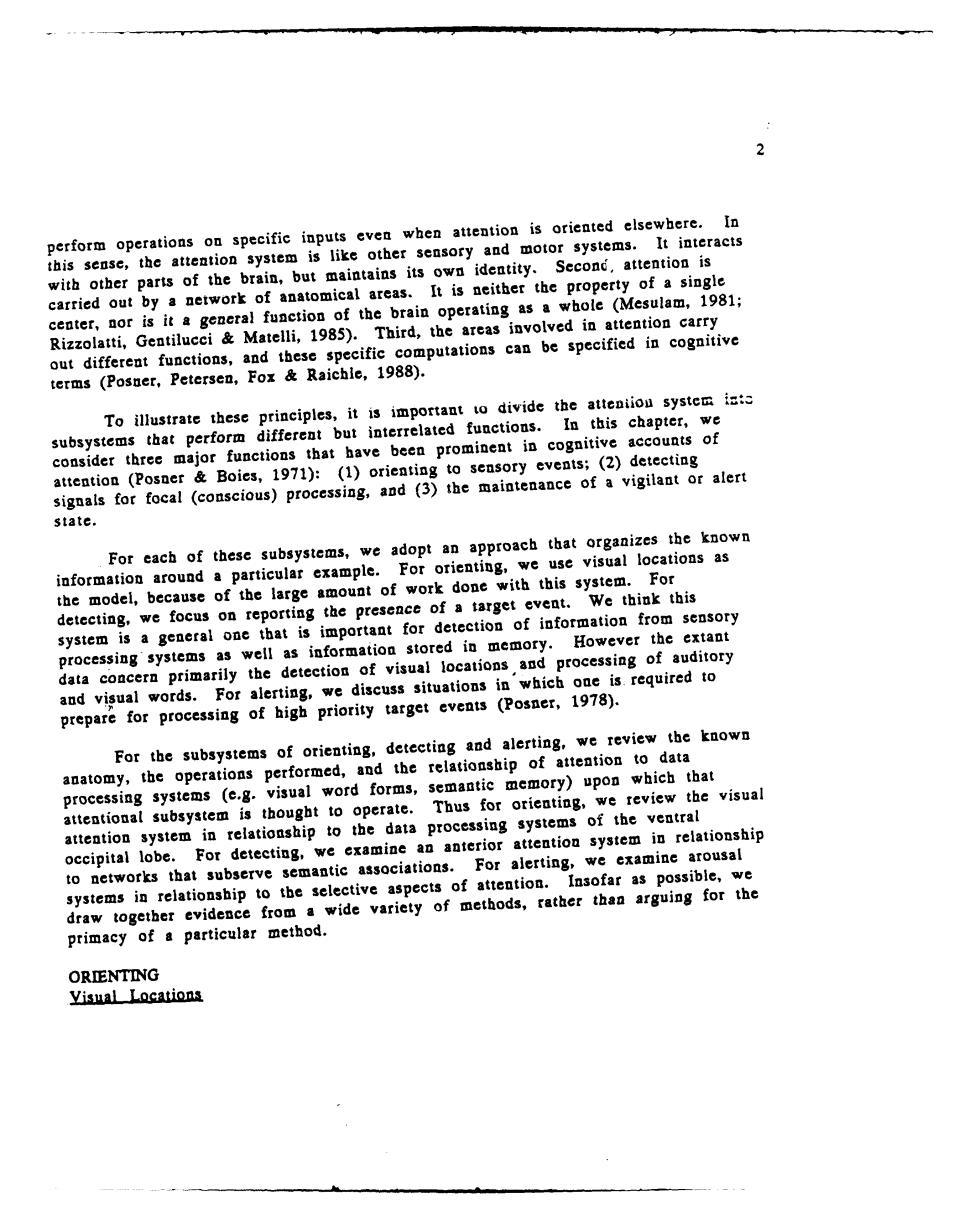
a when attention is oriented elsewhere. interacts with other parts of the brain maintains its own identity. of a single carried out by a network of the brain operatinged in attention carry ceater,orsMatei.9).Third,the Rizzolatti,Ge and these specific computations can be specified in cognitive n For Raichle,1988) tem ists To illustrate these principles,it is imp elated functions. syst we have been prominent in cogni attention (Posner B (1)orienting to seasory :(2)detecting signals for focal(conscio essing and (3)the mainte eveofa vigilant or alert state. For each of these subsystems,we adopt an und a particular example. of the arge of k done with this system nk this we focus on reporti ag tae p for detection of information om sensory tion stored in memory. er the extant data concern pri of visual locations,an and visual words we discuss situations in required to prepare for processing of bigh priority target events (Po 19781 For the subsystems of orienting,detecting and alerting,we review the kaown erations performed,and the aship of aitention to ems (e.g.visual word for memory)upon subsystem is thought to opera Thus for orienting, the visual system in relationship to the cessing systems of an anterior attention syste in relationship cipital lobe.For detecting, to networks that subserve se associations.For alerting, amine arousal ive aspects of attention. as possible,we a wide variety of methods,rather than arguing for the draw together evid primacy of a particular method
2 perform operations on specific inputs even when attention is oriented elsewhere. In this sense, the attention system is like other sensory and motor systems. It interacts with other parts of the brain, but maintains its own identity. SeconC, attention is carried out by a network of anatomical areas. It is neither the property of a single center, nor is it a general function of the brain operating as a whole (Mesulam, 1981; Rizzolatti, Gentilucci & Matelli, 1985). Third, the areas involved in attention carry out different functions, and these specific computations can be specified in cognitive terms (Posner, Petersen, Fox & Raichle, 1988). To illustrate these principles, it is important to divide the attenDti systC i-z subsystems that perform different but interrelated functions. In this chapter, we consider three major functions that have been prominent in cognitive accounts of attention (Posner & Boies, 1971): (1) orienting to sensory events; (2) detecting signals for focal (conscious) processing, and (3) the maintenance of a vigilant or alert state. For each of these subsystems, we adopt an approach that organizes the known information around a particular example. For orienting, we use visual locations as the model, because of the large amount of work done with this system. For detecting, we focus on reporting the presence of a target event. We think this system is a general one that is important for detection of information from sensory processing systems as well as information stored in memory. However the extant data concern primarily the detection of visual locations and processing of auditory and visual words. For alerting, we discuss situations in which one is required to prepare for processing of high priority target events (Posner, 1978). For the subsystems of orienting, detecting and alerting, we review the known anatomy, the operations performed, and the relationship of attention to data processing systems (e.g. visual word forms, semantic memory) upon which that attentional subsystem is thought to operate. Thus for orienting, we review the visual attention system in relationship to the data processing systems of the ventral occipital lobe. For detecting, we examine an anterior attention system in relationship to networks that subserve semantic associations. For alerting, we examine arousal systems in relationship to the selective aspects of attention. Insofar as possible, we draw together evidence from a wide variety of methods, rather than arguing for the primacy of a particular method. ORIENTING Visual Loations
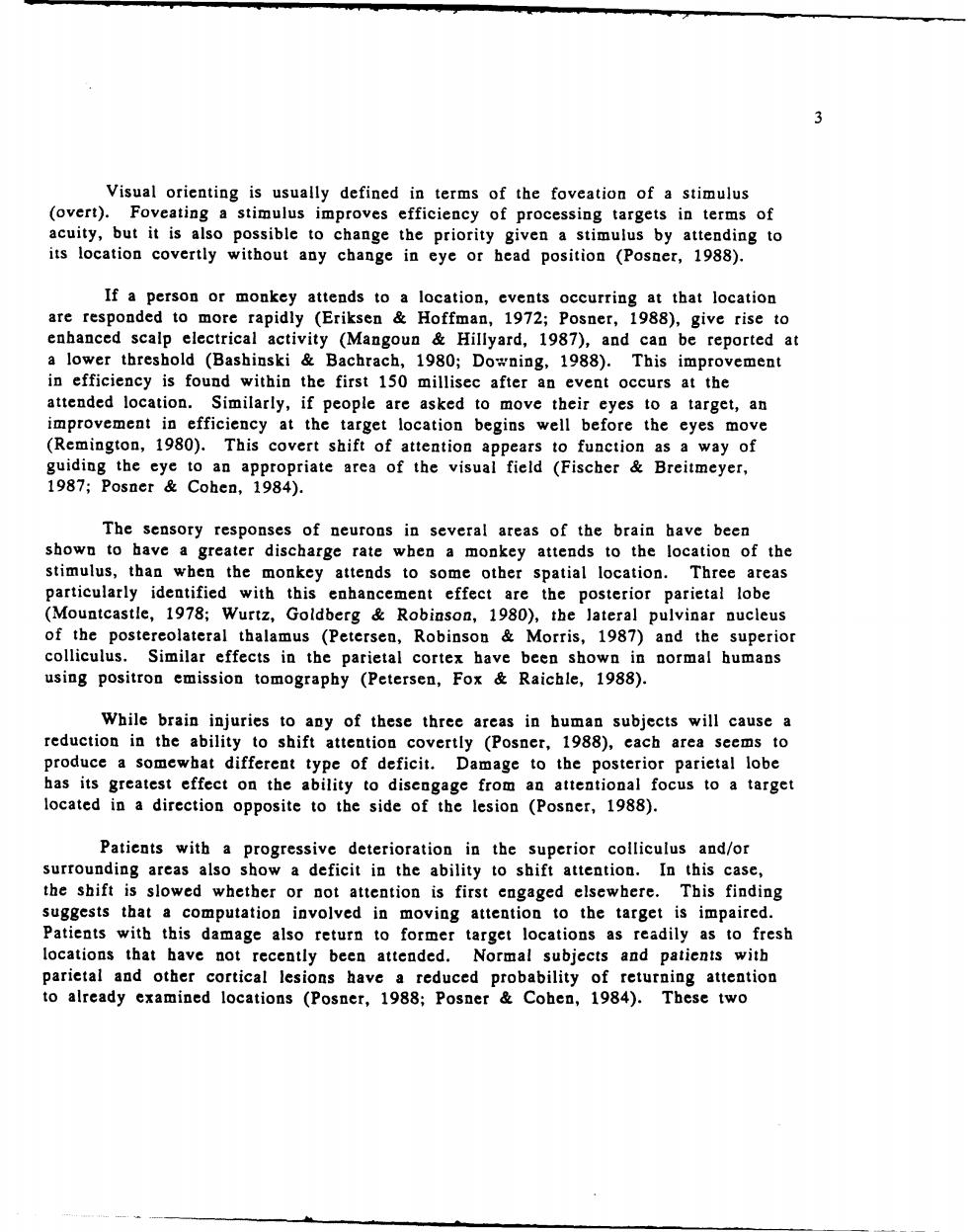
Visual orienting is usually defined in terms of the foveation of a stimulus (overt).Foveating a stimulus improves effici acy of pr or head position (Posmer,1988). If a person or monkey attends to a location,events occurring at that location are responded to more rapidly (Eriksen Hoffman,1972;Posner,1988),give rise to emhanced scalp electrical activity (,1987).be reporteda a lower threshold (Bashinski Bachrach.1980:Do ing,1988). This in efficiency is found within the first 150 millisec an rs a attended location.Similarly people are ed to m eye target,an improvement in efficiene .th rge begins wel (Remin gton,1980).This e cyes mo the cove rt shif a 1 idin。 ention appear 9 a way of 9s7oaer hen, of neurons in several areas shown to hay of the brain have been when a mor stimulus,than grea arge rat key atten to the location of the cy att effe other to son articularly spatial locati with th 1978 Goldberg& inson,19 30),the lateral pulvinar nucleus thalamus (Petersen,Robinson Morris,1987)and the superior ilar effects in the parietal cortex have been shown in normal humans using positron emission tomography (Petersen,Fox Raichle.1989). While brain injuries to any of these three areas in buman subjects will cause a reduction in the ability to shift attention covertly (Posner,1988),cach area seems to produce a somewhat different type of deficit.Damage to the posterior parietal lobe has its greatest effect on the ability to disengage from an attentional focus to a target located in a direction opposite to the side of the lesion (Posner,1988). Patients with a progressive deterioration in the superior colliculus and/or surrounding areas also show a deficit in the ability to shift attention.In this case, the shift is slowed whether or not attention is first engaged elsewhere.This finding suggests that a computation involved in moving attention to the target is impaired. Patients with this damage also return to former target locations as readily as to fresh locations that have not recently been attended.Normal subjects and patients with parietal and other cortical lesions have a reduced probability of returning attention to already examined locations (Posner,1988;Posner&Cohen,1984).These two
3 Visual orienting is usually defined in terms of the foveation of a stimulus (overt). Foveating a stimulus improves efficiency of processing targets in terms of acuity, but it is also possible to change the priority given a stimulus by attending to its location covertly without any change in eye or head position (Posner, 1988). If a person or monkey attends to a location, events occurring at that location are responded to more rapidly (Eriksen & Hoffman, 1972; Posner, 1988), give rise to enhanced scalp electrical activity (Mangoun & Hillyard, 1987), and can be reported at a lower threshold (Bashinski & Bachrach, 1980; Downing, 1988). This improvement in efficiency is found within the first 150 millisec after an event occurs at the attended location. Similarly, if people are asked to move their eyes to a target, an improvement in efficiency at the target location begins well before the eyes move (Remington, 1980). This covert shift of attention appears to function as a way of guiding the eye to an appropriate area of the visual field (Fischer & Breitmeyer, 1987; Posner & Cohen, 1984). The sensory responses of neurons in several areas of the brain have been shown to have a greater discharge rate when a monkey attends to the location of the stimulus, than when the monkey attends to some other spatial location. Three areas particularly identified with this enhancement effect are the posterior parietal lobe (Mountcastle, 1978; Wurtz, Goldberg & Robinson, 1980), the lateral pulvinar nucleus of the postereolateral thalamus (Petersen, Robinson & Morris, 1987) and the superior colliculus. Similar effects in the parietal cortex have been shown in normal humans using positron emission tomography (Petersen, Fox & Raichle, 1988). While brain injuries to any of these three areas in human subjects will cause a reduction in the ability to shift attention covertly (Posner, 1988), each area seems to produce a somewhat different type of deficit. Damage to the posterior parietal lobe has its greatest effect on the ability to disengage from an attentional focus to a target located in a direction opposite to the side of the lesion (Posner, 1988). Patients with a progressive deterioration in the superior colliculus and/or surrounding areas also show a deficit in the ability to shift attention. In this case, the shift is slowed whether or not attention is first engaged elsewhere. This finding suggests that a computation involved in moving attention to the target is impaired. Patients with this damage also return to former target locations as readily as to fresh locations that have not recently been attended. Normal subjects and patients with parietal and other cortical lesions have a reduced probability of returning attention to already examined locations (Posner, 1988; Posner & Cohen, 1984). These two